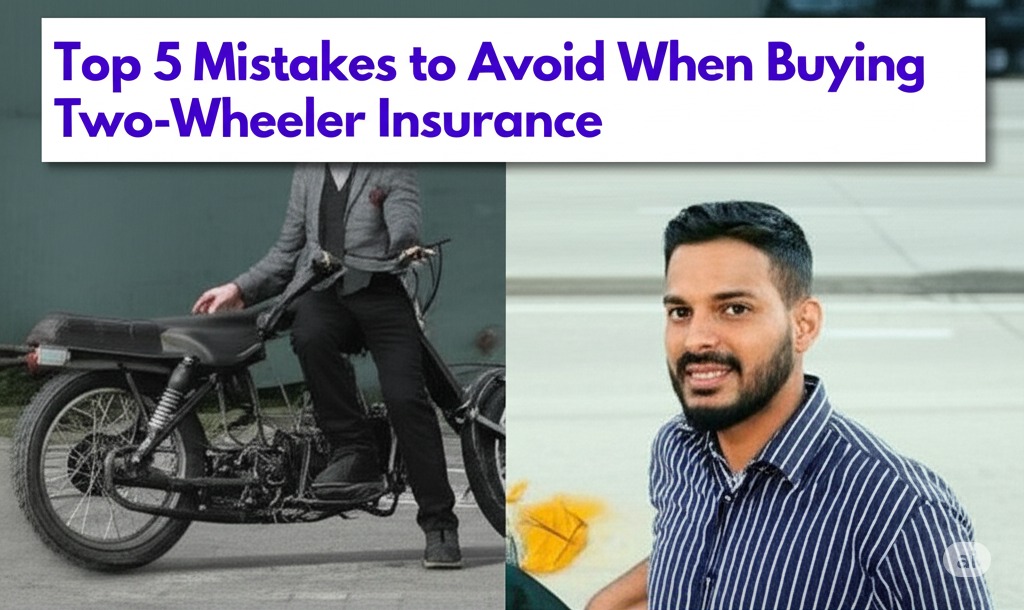Top 5 Mistakes to Avoid When Buying Two-Wheeler Insurance
Introduction
Owning a bike or scooter in 2025 isn’t just about convenience—it’s a necessity in today’s fast-paced world. But while buying a bike is exciting, many people overlook the importance of choosing the right two-wheeler insurance.
Unfortunately, most riders either rush through the insurance process or stick with the default option provided by dealers, without understanding the risks involved. One small mistake in buying insurance can cost you thousands during a claim or even leave you legally unprotected.
In this post, we’ll break down the Top 5 most common mistakes to avoid when buying two-wheeler insurance—plus tips to help you get the best coverage at the best price.
🔥 Why Getting Bike Insurance Right Is So Important
Bike insurance isn’t just a legal formality. It:
- Protects your finances in case of accidents or theft
- Covers third-party liabilities
- Ensures peace of mind
- Prevents fines or vehicle seizure due to non-compliance
A well-chosen policy can mean the difference between smooth compensation and painful out-of-pocket expenses.
🚨 Mistake #1: Choosing Only Third-Party Insurance Without Assessing Risks
What It Means:
Many buyers go for third-party insurance simply because it’s cheaper and mandatory. While this covers legal obligations, it offers no protection for your own bike.
Why It’s a Problem:
- If your bike is damaged in an accident, you’ll get zero compensation.
- If it gets stolen or damaged due to fire or floods, you’ll bear the full loss.
- With increasing vehicle theft and unpredictable weather, this is a risky decision.
What You Should Do:
- Opt for a comprehensive bike insurance policy if your bike is:
- Less than 5 years old
- High-value or premium
- Used frequently for long distances
- Assess your location and riding pattern: urban or theft-prone areas require more coverage.
✅ Pro Tip: Comprehensive insurance also allows for add-ons like zero depreciation, roadside assistance, and engine protection.
🚨 Mistake #2: Ignoring the Insured Declared Value (IDV)
What It Means:
The IDV is the current market value of your bike and forms the basis for your claim amount in case of total loss or theft. Some buyers choose policies with lower IDV to reduce premiums.
Why It’s a Problem:
- A lower IDV means lower claim payout if your bike is stolen or beyond repair.
- You may save a few hundred rupees now but lose thousands later.
What You Should Do:
- Always select the correct IDV based on the bike’s age and model.
- Avoid insurers who offer very low IDV just to lower premiums.
- Check the depreciation chart used by the insurer.
✅ Example: If your actual bike value is ₹70,000 but you insured it for ₹50,000, your claim amount can’t exceed ₹50,000—even for a total loss.
🚨 Mistake #3: Skipping Add-Ons That Provide Extra Protection
What It Means:
Add-ons are optional covers that enhance your insurance policy. Many people skip them thinking they’re unnecessary or too expensive.
Why It’s a Problem:
- You miss out on valuable coverage that can save you during emergencies.
- Some claims may be partially settled or denied due to lack of coverage.
Top Add-Ons You Should Consider:
| Add-On | Benefit |
|---|---|
| Zero Depreciation | Full cost of parts without depreciation cuts |
| Roadside Assistance | Help in case of breakdown, fuel empty, or flat tire |
| Engine Protection | Covers engine damage due to water ingress/floods |
| NCB Protection | Keeps your No Claim Bonus even after 1 claim |
| Personal Accident Cover | Covers accidental injury or death of the rider |
| Consumables Cover | Covers costs of oil, nuts, bolts, brake fluid, etc. |
✅ Pro Tip: Add-ons slightly increase your premium, but can greatly improve claim amounts and experience.
🚨 Mistake #4: Not Comparing Insurance Policies from Multiple Providers
What It Means:
Many buyers either stick to the policy offered by the dealer, or renew their insurance with the same company every year without checking the market.
Why It’s a Problem:
- You may be overpaying for limited coverage.
- Some insurers offer better customer service, higher IDV, or additional benefits at similar or lower prices.
What You Should Do:
- Use comparison sites like PolicyBazaar, Coverfox, or insurance aggregator tools to compare:
- Premiums
- IDV
- Claim settlement ratio
- Add-ons offered
- Customer reviews
- Choose insurers with high claim settlement ratios and good support.
✅ Pro Tip: Always read the policy terms and exclusions before purchasing. Cheapest isn’t always best.
🚨 Mistake #5: Delaying Renewal or Letting the Policy Expire
What It Means:
You either miss the renewal date or let your insurance policy lapse completely.
Why It’s a Problem:
- You become legally non-compliant—you can be fined or even have your bike seized.
- During the lapse period, any damage won’t be covered.
- Renewal may now need physical inspection, higher premium, or even denial of NCB benefits.
What You Should Do:
- Set reminders to renew your insurance at least 7 days before expiry.
- Many insurers offer grace periods—don’t miss them.
- Opt for long-term policies (2-3 years) to avoid yearly renewals.
✅ Pro Tip: Renewing on time helps maintain your No Claim Bonus (NCB) and ensures uninterrupted coverage.
✅ Bonus Tips for Smart Two-Wheeler Insurance Buyers
1. Understand NCB (No Claim Bonus)
- NCB is a discount on premium for not making any claims during a policy year.
- It ranges from 20% (after 1 year) to 50% (after 5 years).
- NCB is transferable even if you change insurers or buy a new bike.
2. Avoid Making Small Claims
- Use your own money for minor repairs to retain NCB.
- Save your insurance for high-value claims.
3. Verify Policy Details Immediately
- Check RC number, engine/chassis numbers, IDV, and add-ons on the policy document.
- Request corrections within the free-look period (usually 15 days).
4. Keep Soft Copies of Your Insurance
- Always keep a PDF copy in your phone and print in your bike’s document file.
5. Know What’s Not Covered (Exclusions)
- Mechanical breakdown
- Riding under the influence
- Driving without a valid license
- Illegal racing
- Wear and tear
Knowing exclusions helps avoid claim rejection surprises.
📌 Summary Table – Mistakes to Avoid
| Mistake | Why It’s Risky | What to Do |
|---|---|---|
| Only buying third-party | No own damage cover | Go for comprehensive if bike is new |
| Choosing low IDV | Low claim payout | Choose correct IDV based on bike’s value |
| Ignoring add-ons | Less protection | Pick relevant add-ons |
| Not comparing plans | Higher costs, fewer benefits | Compare multiple insurers |
| Delayed renewal | Legal risk & no coverage | Renew on time & consider long-term policies |
🏁 Final Thoughts
Buying two-wheeler insurance is more than a legal necessity—it’s your shield against unpredictable and costly events. Don’t let simple oversights or rushed decisions cost you heavily later.
By avoiding the top 5 mistakes mentioned above, you can:
- Get maximum protection
- Pay a fair premium
- Experience a smooth claim process
- Enjoy peace of mind every time you ride


